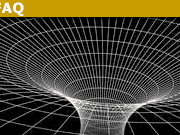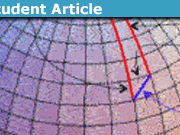Tolman Law in a Nutshell
The Tolman law describes how the temperature in a fixed gravitational field depends on the position (see https://arxiv.org/abs/1803.04106 for a pedagogic review). Here I present a simple general derivation of the Tolman law. It’s generally in the sense that it is applicable to any (thermalized) physical degrees of freedom for which one can define Lagrangian and Hamiltonian. It’s simple in the sense that, in the derivation, one does not need to care about any details of those physical degrees of freedom, while general relativity is applied at a rather elementary level. To achieve simplicity, at some points I use heuristic arguments based on physical intuition, thus avoiding mathematical rigor. After the derivation, I briefly discuss a few elementary examples.
Table of Contents
Derivation of the Tolman law
In a static spacetime, the metric ##g_{\mu\nu}## satisfies ##g_{0i}=0##, while ##g_{00}(x)=g_{00}({\bf x})## and ##g_{ij}(x)=g_{ij}({\bf x})## do not depend on the global coordinate time ##t=x^0##. Consider a local static observer at the position ##{\bf x}##. For any local physical quantity ##A##, I introduce the notation ##A_{\rm obs}## denoting the value of ##A## as measured by such a local observer. In particular
$$dt_{\rm obs}=\sqrt{g_{00}({\bf x})} dt .$$
For any physical system (e.g. a system of particles or matter fields) the action can be written in a schematic form
$$S=\int dt_{\rm obs}\, L_{\rm obs}$$
where ##L_{\rm obs}## is the observable Lagrangian. (For instance, if the Lagrangian is equal to kinetic energy, then observable Lagrangian is the observable kinetic energy as measured by the local static observer.) Combining the two equations above, we have
$$S=\int dt\, L$$
where
$$L=\sqrt{g_{00}({\bf x})} L_{\rm obs} .$$
Hence the canonical Hamiltonian ##H## derived from ##L## has an analogous form
$$H(q,p)=\sqrt{g_{00}({\bf x})} H_{\rm obs}(q,p) $$
where ##q,p## are the variables of the physical system in the phase space. For an arbitrary Hamiltonian system in thermal equilibrium, Boltzmann has shown that probability distribution in the phase space is proportional to
$${\rm exp}\left(-\frac{H(q,p)}{kT}\right)$$
where ##k## is the Boltzmann constant and ##T## is the temperature. The temperature ##T## is a constant in the thermal equilibrium. By writing it in terms of the observable Hamiltonian ##H_{\rm obs}## as
$${\rm exp}\left(-\frac{H_{\rm obs}(q,p)}{kT/\sqrt{g_{00}({\bf x})}}\right)$$
we see that ##T/\sqrt{g_{00}({\bf x})}## is naturally interpreted as the observable temperature
$$T_{\rm obs}({\bf x})=\frac{T}{\sqrt{g_{00}({\bf x})}} .$$
This last equation is known as the Tolman law.
Tolman law expressed in terms of Newton potential
It is useful to rewrite the Tolman law in terms of the Newton potential ##V({\bf x})##. In general, we have
$$g_{00}({\bf x})=1+\frac{2V({\bf x})}{c^2}$$
where ##c## is the speed of light. In the Newtonian limit we have ##2V({\bf x})\ll c^2##, so the Taylor expansion gives
$$T_{\rm obs}({\bf x}) \approx T \left( 1-\frac{V({\bf x})}{c^2} \right) .$$
In particular, near the surface of the Earth we have ##V({\bf x}) \approx V_0 +gz##, where ##z## is the vertical coordinate and ##g## is the acceleration of the free fall, so
$$T_{\rm obs}({\bf x}) \approx T \left( 1-\frac{V_0 +gz}{c^2} \right) .$$
Tolman law around the black hole
For the Schwarzschild black hole we have
$$g_{00}(r)=1-\frac{2GM}{c^2r}=1-\frac{r_S}{r}$$
where ##r_s## is the Schwarzschild radius. Hence the Tolman law gives
$$T_{\rm obs}(r)=\frac{T}{\sqrt{1-\frac{r_S}{r}}} .$$
In particular
$$T_{\rm obs}(\infty)=T, \;\;\; T_{\rm obs}(r_s)=\infty .$$
If the temperature arises from Hawking radiation by the black hole, then ##T## is the Hawking temperature
$$T=\frac{\hbar c^3}{8\pi Gk M}.$$
Theoretical physicist from Croatia










The intensity of the laser will have to increase steadily to maintain constant acceleration.
"
So what?
"
The accelerated observer will always see the reactor only as a point source of gravity (retarded)
"
If you are using Newtonian gravity, this is not correct; there is no retardation in Newtonian gravity.
If you are using relativity, gravity is not a force, it's spacetime curvature, sourced by stress-energy. All of the stress-energy that is going to be pumped into the laser is already in the past light cone of the accelerated observer before the laser even turns on. So retardation is irrelevant.
"
The laser he will only notice when it hits him
"
He will only notice the acceleration due to the laser when it hits him, yes. But that does not mean he only notices the gravity due to the stress-energy that gets pumped into the laser when it hits him. See above.
"
and probably the gravity of the light reflected
"
As already stated, all of the stress-energy that causes the "gravity" the accelerated observer senses is already in his past light cone before the laser even turns on.
The reflection of the laser light does put some of that stress-energy closer to the accelerated observer than it would otherwise be, which I think (I haven't done the detailed math to check) will increase somewhat the gravity the accelerated observer measures, from what it would have been if the laser had not fired. But that doesn't mean the accelerated observer measures no gravity at all until the laser hits him. See above.
For a laser beam, it should be possible to estimate the effect of the energy density of the laser.
"
You don't have to estimate; the stress-energy tensor of an EM field is well known.
https://en.wikipedia.org/wiki/Electromagnetic_stress–energy_tensor
"
The accelerated system can only see the gravity of the light already reflected.
"
Not at all. The source of the laser, which must contain enough energy to supply it, will already be in the past light cone of the accelerated system, along with its gravity.
Sure, a rocket of ordinary size, even counting all of its fuel and rocket exhaust, won't be enough stress-energy to curve spacetime–but it also won't provide enough acceleration to serve as any kind of illustration of Tolman's law; the temperature gradient due to the variation in ##g_{00}## with position will be many, many orders of magnitude too small to detect. If you're going to say we could in principle detect such small temperature differences, then we could just as well in principle detect such small amounts of spacetime curvature. The two go together; you can't just arbitrarily take one into account and ignore the other.
Similar remarks would apply to any other source of acceleration, like a laser beam.
"
For a laser beam, it should be possible to estimate the effect of the energy density of the laser. The accelerated system can only see the gravity of the light already reflected. This intensity is maximal and constant in time (judged from the accelerated system) but proportional to acceleration directly at the reflector. The gravitational potential due to light reflected at earlier times should be integrable due to redshift. Maybe one could estimate whether it increases linearly or sub-linearly with acceleration?
When you really fear that you need a rocket so heavy, that its gravity would disturb the system, which I consider quite unlikely, you could imagine other sources of acceleration like reflection of a laser beam.
"
Sure, a rocket of ordinary size, even counting all of its fuel and rocket exhaust, won't be enough stress-energy to curve spacetime–but it also won't provide enough acceleration to serve as any kind of illustration of Tolman's law; the temperature gradient due to the variation in ##g_{00}## with position will be many, many orders of magnitude too small to detect. If you're going to say we could in principle detect such small temperature differences, then we could just as well in principle detect such small amounts of spacetime curvature. The two go together; you can't just arbitrarily take one into account and ignore the other.
Similar remarks would apply to any other source of acceleration, like a laser beam.
But in flat spacetime, you can't just magically say the fluid accelerates; something has to be making it accelerate, and that something has to be expending energy (like a rocket engine). And you have to include the energy involved in that in your analysis as well. That means there is even more stress-energy present in your model, which isn't compatible with flat spacetime, and it also means there is the possibility of other heat transfer that your model does not include.
"
When you really fear that you need a rocket so heavy, that its gravity would disturb the system, which I consider quite unlikely, you could imagine other sources of acceleration like reflection of a laser beam.
The variation of Unruh temperature is exactly a manifestation of Tolman law. It appears because ##g_{00}## is not a constant in an accelerated frame. Tolman law does not require a curvature.
"
Mathematically, if you assume spacetime is flat and that you have a perfect fluid whose worldlines are the Rindler congruence, yes, you will obtain Tolman's Law.
However, those assumptions are not really consistent, because "perfect fluid" implies nonzero stress-energy, and flat Minkowski spacetime is not a solution of the EFE for nonzero stress-energy. Similar remarks apply to Unruh radiation; giving the radiation a nonzero energy density, which is required for it to have a nonzero temperature, is not really consistent with spacetime being flat. (Calling the energy density "vacuum energy density" doesn't help; that just means you have a nonzero cosmological constant, and flat Minkowski spacetime is not a solution of the EFE for a nonzero cosmological constant either.)
Also, if you have a perfect fluid with accelerated worldlines, something has to be producing that acceleration. A static, spherically symmetric configuration of matter can do that without expending energy because of the particular way it curves spacetime. But in flat spacetime, you can't just magically say the fluid accelerates; something has to be making it accelerate, and that something has to be expending energy (like a rocket engine). And you have to include the energy involved in that in your analysis as well. That means there is even more stress-energy present in your model, which isn't compatible with flat spacetime, and it also means there is the possibility of other heat transfer that your model does not include.
I understand the use of the flat spacetime Rindler case as a heuristic; I just don't think it can do all the work that is being ascribed to it in this thread.
https://hal.archives-ouvertes.fr/hal-02299780/file/Black_Body_Radiation_in_Moving_Frames.pdf
N. G. van Kampen, Relativistic thermodynamics of moving systems, Phys. Rev. 173, 295 (1968),
https://doi.org/10.1103/PhysRev.173.295
the observed Unruh temperature will also vary from bottom to top. But this has nothing to do with Tolman's law, because there is no gravitational potential; spacetime is flat. Tolman's law is about the effects of curved spacetime.
"
That's wrong. The variation of Unruh temperature is exactly a manifestation of Tolman law. It appears because ##g_{00}## is not a constant in an accelerated frame. Tolman law does not require a curvature.
You are quite negative.
"
I am actually being charitable; your posts are verging on personal speculation, which is off limits at PF.
"
three possible transformation laws for temperature between inertial systems
"
Which has nothing to do with Tolman's Law, since "inertial systems" implies flat spacetime and SR; in GR in curved spacetime there are no global inertial systems. Any comparison between temperatures at different locations in a gravitational field can't be done using inertial systems, because any comparison between any properties at different locations in a gravitational field in curved spacetime can't be done using inertial systems.
"
All I am trying to say is that from the Tolman temperature one should be able to show which of these relations is compatible on grounds of the principles of general relativity.
"
Sorry, but this is simply incorrect, no matter how plausible it appears to you. See above.
All I am trying to say is that from the Tolman temperature one should be able to show which of these relations is compatible on grounds of the principles of general relativity.
The gravitational potential of the second observer
"
Could just as well be that of an observer standing on the surface of the shell Earth, since the gravitational potential is the same there as everywhere inside the shell (the gravitational potential everywhere inside the shell is constant).
"
is ##-gr_0=-v_0^2##
"
The ##g r_0## part is correct, for the humdrum reason that the gravitational potential at the surface of any spherically symmetric massive body with mass ##M## and radius ##R## is ##U = – GM / R##, and the acceleration ##g## given by the gradient of that potential is ##- GM / R^2##, so ##g = U / R##.
The ##v_0^2## part, however, is wrong. If you check the math, you will see that ##g r_ 0 = v_0^2 / 2## for your scenario. Which tells us nothing whatever about the gravitational field of the Earth or anything else; all it tells us is that kinetic energy per unit mass is ##v^2 / 2## for motion in a straight line in flat spacetime. In other words, it's just the work-energy theorem in disguise.
"
This looks suspiciously as if ##g_{00}## can be expressed in terms of ##1-v_0^2/c^2## upon a more exact relativistic calculation.
"
Numerology is not physics. If you actually do the relativistic calculation, you will see that your suspicion is wrong.
The other one accelerates so that he experiences at every point of time the same accelleration as the other person experiences gravitational acceleration
"
"At every point of time" is frame dependent.
Also, neither of the accelerations are "gravitational acceleration"; neither one is at rest in a gravitational field. The observer inside the spherical shell Earth is accelerating in a flat region of spacetime, just like (to a good approximation) the observer far away. Neither of them is standing at rest on the surface of the spherical shell, which is what they would have to do to be at rest in a gravitational field.
"
In the end one is at rest in the center of earth and the other one moves in free space with a constant relative velocity relative to earth.
"
What is this supposed to show?
This local equivalence is not what you appear to think it is. It is a local equivalence of proper acceleration of a given magnitude (say 1 g) for two observers: one inside a rocket whose engine is firing in flat spacetime, and the other who is at rest in a gravitational field (e.g., on the surface of the Earth). It is not "local equivalence of acceleration and gravitation" as a general hand-waving thing. In your scenario, there is no pair of observers who satisfy the two conditions above, so the equivalence principle is irrelevant.
"
Really? Let me formulate it differently? I consider 2 observers which are both far from earth to begin with, at rest relative to earth. One is brought with constant speed to earth (modelled as a spherical shell) and then decellerates with one g until he reaches the center. The other one accelerates so that he experiences at every point of time the same accelleration as the other person experiences gravitational acceleration. In the end one is at rest in the center of earth and the other one moves in free space with a constant relative velocity relative to earth.
In principle, one could use the Tolman argument in conjunction with the local equivalence of acceleration and gravitation.
"
This local equivalence is not what you appear to think it is. It is a local equivalence of proper acceleration of a given magnitude (say 1 g) for two observers: one inside a rocket whose engine is firing in flat spacetime, and the other who is at rest in a gravitational field (e.g., on the surface of the Earth). It is not "local equivalence of acceleration and gravitation" as a general hand-waving thing. In your scenario, there is no pair of observers who satisfy the two conditions above, so the equivalence principle is irrelevant.
From the preceeding discussion, we know already how to compare temperatures of two persons relative at rest to each other, one located inside earth and the other one far away. The latter one can now compare to another person also far away from earth but at a different speed.
Without any calculation I can say that it's pretty much hotter in the center of the Sun than somewhere far away from it ;-) SCNR.
"
The Sun is not in thermal equilibrium; it radiates far more energy away to space than it absorbs. So Tolman's Law would not apply to the temperature distribution in the Sun.
As the quotient of observable temperature and observable Hamiltonian is the same as that of the temperature T_0 and the canonical Hamiltonian, would it make sense to call T_0 canonical temperature?
a gravitational potential usually goes in hand with a gravitational acceleration
"
Usually, yes. But that doesn't mean they are the same thing or that they are interchangeable when trying to understand particular phenomena.
"
Your explanation of the Unruh effect seems to me to be at variance with the one given in the paper by Buchholz and Velch. If I understand it correctly, the accelerated vacuum has still temperature 0, but the thermometer will not show the same reading as it would in an inertial system.
"
I'm still re-reading that paper, since I am so far unable to understand their argument. They seem to be contradicting themselves: they say there is heat exchange, but they also say the temperature is uniform everywhere (and that there is no gravitational potential involved so Tolman's law, they claim, does not predict that the locally measured temperature should vary with position). Those claims do not seem consistent with each other.
But hollow stars are somewhat scarce in nature, hence a gravitational potential usually goes in hand with a gravitational acceleration.
Your explanation of the Unruh effect seems to me to be at variance with the one given in the paper by Buchholz and Velch. If I understand it correctly, the accelerated vacuum has still temperature 0, but the thermometer will not show the same reading as it would in an inertial system.
I think the Unruh example shows that the reading of a thermometer depends on gravitational potential.
"
Tolman's Law in general shows that the reading of a thermometer depends on gravitational potential. That's what we've been talking about this entire thread.
The Unruh effect is a separate issue; see further comments below.
"
I am refering to the equivalence of acceleration and gravitation locally in GR.
"
Which has nothing to do with gravitational potential. Gravitational potential is not the same as acceleration.
"
a constantly accelerated thermometer will show the same temperature as a thermometer in a gravitational potential.
"
No, this is not correct. The equivalence principle says that if you are experiencing a proper acceleration of 1 g, you can't tell, locally, whether that is because you are standing at rest on the surface of the Earth, or in a rocket in free space whose engine is supplying just enough force to produce a 1 g proper acceleration. It does not say that the gravitational potential is the same in both cases.
The Unruh effect says that, if the quantum field in flat spacetime is in a vacuum state as seen by inertial observers, then an observer with constant proper acceleration will observe a thermal bath of particles at the Unruh temperature. The Unruh temperature itself depends on the proper acceleration, so in a very tall rocket in flat spacetime, tall enough so that the proper acceleration varies appreciably from bottom to top, the observed Unruh temperature will also vary from bottom to top. But this has nothing to do with Tolman's law, because there is no gravitational potential; spacetime is flat. Tolman's law is about the effects of curved spacetime.
No, it means the local quantity, temperature, is ##T(x)##, not ##T_0##. I don't understand why you think this is a problem. Why wouldn't the quantity that a local thermometer measures be "temperature"?
"
I think the Unruh example shows that the reading of a thermometer depends on gravitational potential.
"
What you are calling ##g##, the thing that appears in the formula for ##T(x)##, is actually gravitational potential, not gravitational acceleration. (If you look at the Insights article, you will note that the ##g## there has indexes–it is ##g_{00} (\mathbf{x})##, which is the metric coefficient that, in suitably chosen coordinates, corresponds to the gravitational potential.)
"
No, I am refering to the equivalence of acceleration and gravitation locally in GR. Hence a constantly accelerated thermometer will show the same temperature as a thermometer in a gravitational potential.
So basically, it boils down to temperature not being a local quantity any more
"
No, it means the local quantity, temperature, is ##T(x)##, not ##T_0##. I don't understand why you think this is a problem. Why wouldn't the quantity that a local thermometer measures be "temperature"?
"
As any ##g## can be viewed as resulting from an acceleration
"
What you are calling ##g##, the thing that appears in the formula for ##T(x)##, is actually gravitational potential, not gravitational acceleration. (If you look at the Insights article, you will note that the ##g## there has indexes–it is ##g_{00} (\mathbf{x})##, which is the metric coefficient that, in suitably chosen coordinates, corresponds to the gravitational potential.)
To answer the question myself, I found the following article by Buchholz:
https://arxiv.org/pdf/1505.01686.pdf
They maintain the oppinion, that the temperature of an accelerated vacuum remains 0 and interpret the temperature shown by a thermometer as an analogue of friction.
Another question is, how to measure the temperature of some object at a distance like a star. The only quantities we can measure within GR are local quantities. So to measure the temperature of a star (as our Sun) we use the spectrum of its emitted em. radiation and fit a Planck distribution to it. Then we get an "effective temperature", but this temperature is not the temperature as defined locally but the radiation is shifted due to the Doppler effect (if the star is moving relative to our local inertial frame) and due to gravity (indeed the gravitational redshift of the spectral lines of the Sun was one of the first predictions about general-relativistic effects by Einstein). This you have to take into account to get the "true" or "proper" temperature of the distant object. That's also nicely discussed in the above quoted Eur. J. Phys. paper.
But then, ##T(r) = T_0/\sqrt(g)##, so they both have the same temperature ##T_0##, don't they?
"
The temperature that local observers at each height measure is ##T(r)##. ##T_0##, as the arxiv paper says, is just an integration constant, not an observed temperature (except for the observer at infinity, who, if he is in thermal equilibrium with observers at other heights–no net heat flow–will locally measure temperature ##T_0##).
Only when the locally measured temperatures at the two objects match the function ##T(r)## will there be no net heat flow.
"
But then, ##T(r) = T_0/\sqrt(g)##, so they both have the same temperature ##T_0##, don't they?
Of course also the em. interaction is long-ranged (after all it's described by a massless field). Already in this case you have to take care of the long-ranged nature by first shuffling a "mean-field piece" of the collision term to the left-hand side of the Boltzmann equation, which leads to the Vlasov equation, if you neglect all the rest of the "collision term". Then you have a self-consistent theory for the motion of the charged particles and the em. field (a "collisionless" Plasma). This neglects dissipation since the mean-field part cannot lead to entropy production. Taking then the remaining interactions into account you get a usual collision term with short-ranged interactions, because you have Debye screening in the plasma and then the usual Boltzmann (or Fermi-Dirac) distributions as equilibrium states.
This is different for gravity, because there is no screening and it's always attractive, and that's why the universe as a whole doesn't simply look like a boring equilibrated Boltzmann gas but shows all the structure like galaxies, galaxy clusters, the characteristic fluctuations of the CMBR, and all that.
I don't see that the zeroth law fails in GR.
"
It doesn't fail, it just has to be formulated properly to take gravitational effects into account.
"
Of course you can introduce some local T(r) with different properties, but I don't see why it should be called temperature.
"
Because ##T(r)## is what predicts whether there will be net heat flow. Suppose we have two objects at different heights that can exchange heat–say by radiation. If they are both at the same locally measured temperature, then there will be net heat flow from the higher object to the lower object, because the radiation from the higher object will be blueshifted when it reaches the lower object, so its locally measured temperature at the lower object will be higher and it will heat the lower object up; and the radiation from the lower object will be redshifted when it reaches the higher object, so its locallly measured temperature at the higher object will be lower and it will cool the lower object down. Only when the locally measured temperatures at the two objects match the function ##T(r)## will there be no net heat flow.
Relativistic thermodynamics and kinetic theory has been a subject of quite a lot of debate for some decades since 1905. At least in my scientific community, relativistic heavy ion collisions, where hydrodynamics is kind of a "Standard Model" to describe the hot and dense fireball created in such collisions, the consensus is to use the definitions, where the thermodynamic potentials, temperature, etc. are all described as scalar quantities, i.e., being defined in the one frame of reference that is preferred by the physical situation, i.e., the local rest frames of the fluid cells. In kinetic theory also the phase-space distribution functions are scalars. AFAIK also the relativistic astrophysicists, who are quite closely related to our research in heavy-ion collisions (neutron star models need the nuclear/QCD equation of state, gravitational waves from neutron-star mergers/kilonovae are new probes to learn about this equation of state and thus complements and extends the tool box we have in heavy-ion collisions on Earth), follow this concept within GR.
It's an easy understandable fact that the non-relativistic macroscopic equations for transport (heat conduction, dissipative hydro), i.e., first-order-in-gradients approximations taking into account dissipation beyond the ideal-fluid description, cannot be simply extended to a relativistic theory. For that you need to take into account at least the 2nd order in gradients. Using the relaxation-time approximation for the Boltzmann equation this leads to Israel-Stewart hydro. In the past 20 years there has been a lot of progress in understanding dissipative relativistic fluid dynamics in terms of using higher moments in their derivation from relativistic kinetic theory and their validity range compared to kinetic theory.
PS: This is more a critique of the arxiv article than the of the excellent Insights article.
in the arxiv articlefrom the first post
"
Ok, that clarifies what ##T_0## is (it's basically the same as ##T## in the Insights article), but it doesn't explain what you mean by ##T_0## being the "correct" temperature. The arxiv paper clearly states that ##T_0## is an "integration constant" and that the temperature that determines thermal equilibrium is what it calls ##T(r)## or ##T(x)## (and what the Insights article calls ##T_\text{obs}##), i.e., as the arxiv paper states, in a gravitational field "the equilibrium temperature of a spherically symmetric static distribution of a perfect fluid is not uniform". So it would seem to me that a single value, whether it's ##T_0## or any other single value, can't be "correct" as a description of this situation.
What do you mean by "T_0" and "the correct temperature"?
"
… in the arxiv articlefrom the first post.
In my understanding, T_0 is the correct temperature.
"
What do you mean by "T_0" and "the correct temperature"?
the zeroth law, which demands that temperature has to be the same for persons being in thermodynamical equilibrium
"
The problem with this is that it doesn't work as it stands in a gravitational field. Two objects at different altitudes in a gravitational field must be at different temperatures if they are to be in thermodynamical equilibrium with each other. Or, if we have a continuous fluid in a gravitational field, the temperature of the fluid must vary with altitude if it is in thermodynamical equilibrium. That is the point of Tolman's law.
The zeroth law has to be modified to cover such cases, to make clear that it only holds locally, in a patch of spacetime small enough that the effects of spacetime curvature can be neglected. (Strictly speaking, the patch also has to be small enough that any path curvature, i.e., proper acceleration, of objects of interest can also be neglected.)
https://en.wikipedia.org/wiki/Relativistic_heat_conduction
https://itp.uni-frankfurt.de/~greif/Bachelorarbeit.pdf